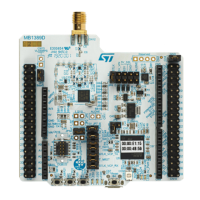RM0453 Rev 1 957/1461
RM0453 Low-power timer (LPTIM)
981
28.4.4 LPTIM reset and clocks
The LPTIM can be clocked using several clock sources. It can be clocked using an internal
clock signal which can be any configurable internal clock source selectable through the
RCC (see RCC section for more details). Also, the LPTIM can be clocked using an external
clock signal injected on its external Input1. When clocked with an external clock source, the
LPTIM may run in one of these two possible configurations:
• The first configuration is when the LPTIM is clocked by an external signal but in the
same time an internal clock signal is provided to the LPTIM from configurable internal
clock source (see RCC section).
• The second configuration is when the LPTIM is solely clocked by an external clock
source through its external Input1. This configuration is the one used to realize Timeout
function or Pulse counter function when all the embedded oscillators are turned off
after entering a low-power mode.
Programming the CKSEL and COUNTMODE bits allows controlling whether the LPTIM
uses an external clock source or an internal one.
When configured to use an external clock source, the CKPOL bits are used to select the
external clock signal active edge. If both edges are configured to be active ones, an internal
clock signal should also be provided (first configuration). In this case, the internal clock
signal frequency should be at least four times higher than the external clock signal
frequency.
28.4.5 Glitch filter
The LPTIM inputs, either external (mapped to GPIOs) or internal (mapped on the chip-level
to other embedded peripherals, such as embedded comparators), are protected with digital
filters that prevent any glitches and noise perturbations to propagate inside the LPTIM. This
is in order to prevent spurious counts or triggers.
Before activating the digital filters, an internal clock source should first be provided to the
LPTIM. This is necessary to guarantee the proper operation of the filters.
Table 197. LPTIM2 input 1 connection
lptim_in1 LPTIM2 input 1 connected to
lptim_in1 GPIO pin as LPTIM2_IN1 alternate function
lptim_in1 COMP1_OUT
lptim_in1 COMP2_OUT
lptim_in1 COMP1_OUT or COMP2_OUT
Table 198. LPTIM3 input 1 connection
lptim_in1 LPTIM3 input 1 connected to
lptim_in1 GPIO pin as LPTIM3_IN1 alternate function
lptim_in1 COMP1_OUT
lptim_in1 COMP2_OUT
lptim_in1 COMP1_OUT or COMP2_OUT

